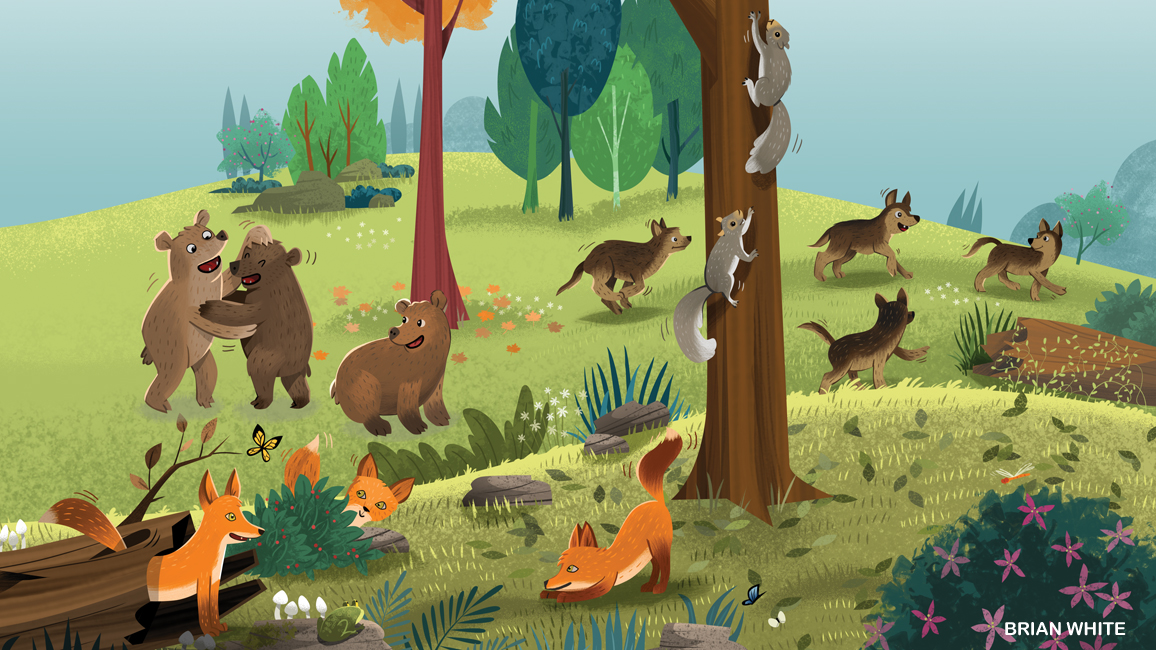
Wild Brothers and Sisters
By Kate Hofmann; Art by Brian WhiteGreat pals? Or real pains? Brothers and sisters can be both—in the animal world as well as in yours!
Do you have brothers or sisters? If so, you have something in common with many wild creatures. Brothers and sisters, also called siblings, are an important part of many animals’ lives.
In some animal families, there are just a few siblings. In others, there are too many to count. Some siblings get along, and others don’t. Some spend their whole lives together, and others never even meet. Read on for a peek at brothers and sisters throughout the animal world.
PLAY ALL DAY
For bears, wolves, foxes, lions, and many other mammals, sibling play is a big part of growing up. From morning to night, siblings leap, chase, wrestle, and pounce on each other. Sometimes somebody bites too hard. Sometimes somebody hogs the best bits of lunch. But everybody ends up sound asleep in a fuzzy pile, getting the rest they need so they can play more when they wake up.
Scientists think that playing with siblings is one way for animals to learn things they’ll need to know when they’re grown up. Tag games might teach them how to sneak up and pounce on dinner. Play-fighting makes siblings tough. Chasing each other helps animals build strong muscles so they can run fast or leap high. But scientists think maybe there’s another reason for all this play: It’s just fun!
HOW MANY?
Four of a Kind. If you were a nine-banded armadillo, you’d have three siblings just like you. These mammals are always born as identical quadruplets. That means there are four brothers or four sisters that are exact copies of each other.
Hundreds of Siblings. Naked mole-rats live in the grasslands of eastern Africa in huge underground colonies. A single queen gives birth to all the other members of the colony. There can be more than two hundred of these hairless, nearly blind brothers and sisters. What happens when two come face to face in a narrow tunnel? It depends on each one’s age, size, and rank. The “underdog” lies down so the “top dog” can walk right over it!
Safety in Numbers. In most frog species, the mother frog lays a large mass of eggs and then leaves. The tadpoles all hatch around the same time, and they often stick close together after hatching. That’s because one tiny tadpole is easy pickings for a hungry predator. But when it is surrounded by many siblings, it’s much less likely to be the one that is eaten.
GETTING AROUND
 Shrew Caravan. Baby European shrews are tiny. They also move fast and are mostly blind. If one wandered away from its sibling group, it could easily get lost. So, when a shrew mother needs to lead her family somewhere, one of the babies bites onto Mom right above her tail. The rest line up behind, each baby latching on to the brother or sister in front of it. Off they march, lickety-split!
Shrew Caravan. Baby European shrews are tiny. They also move fast and are mostly blind. If one wandered away from its sibling group, it could easily get lost. So, when a shrew mother needs to lead her family somewhere, one of the babies bites onto Mom right above her tail. The rest line up behind, each baby latching on to the brother or sister in front of it. Off they march, lickety-split!
SIBLING RIVALS
Sibling Nibbling. Black widow spiders aren’t exactly family types. Hundreds of babies hatch together, but the stronger ones may quickly gobble up their weaker brothers and sisters. Only a few of the siblings survive to grow up. This is nature’s way of making sure the strongest babies have enough food to survive.
The Imposter. Some “siblings” aren’t even related. For example, cowbird mothers lay eggs in the nests of other birds instead of making nests and raising their own chicks. When the eggs hatch, the cowbird chick is usually bigger and pushier than the other baby birds. But the parents treat all the kids alike—even as the hungry cowbird eats more than its fair share of the food they bring!
BETTER TOGETHER
Everybody Pitch In. The more siblings a baby sea turtle has, the better. A sea turtle mom digs a hole on a sandy beach and lays a pile of eggs. Then she covers them with sand. When the tiny turtles hatch, they have to dig their way up through the sand and out of the nest. That takes a lot of energy, and one turtle alone probably couldn’t make it. But when the siblings all work together, it’s easier.
Mother’s Helpers. For humans, it’s totally normal for older kids to help out with younger siblings. Crows do this, too. Some young crows stick around and help when their parents have more babies. They bring sticks to help build the nest and find food for their mom and the new chicks.
FRIENDS FOR LIFE
Family Forever. Orcas travel and hunt together in family groups called pods. In some pods, both brothers and sisters stay with their moms for their whole lives. Brothers will leave to mate with females from other pods, but then they return to their own pods. They don’t help take care of their own babies, but they do help to feed and protect their younger siblings and their sisters’ babies.
Brothers Only. Cheetah brothers are lifelong companions. When cheetahs are first born, all the siblings do everything together. The cubs even stay together after their mom leaves. But after two years, each of the sisters goes off to start a family of her own. Then the brothers form a “boys only” club. They all share a territory and hunt together for the rest of their lives.


























